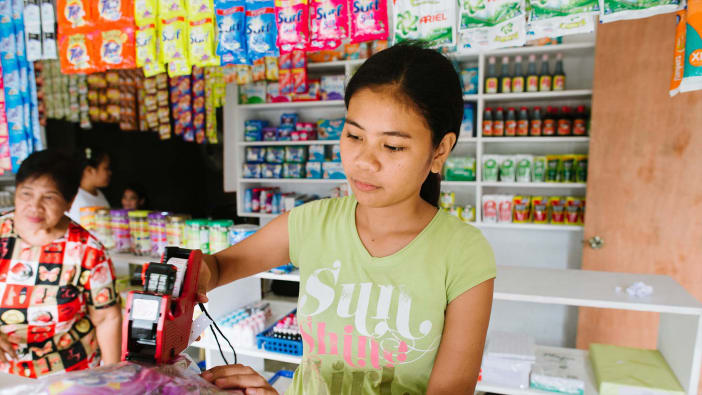by Bhima Sangha and CWC with Paul Stephenson.
The story of the BHIMA SANGHA children, a union of working children in Karnataka, is a fascinating one of how children are organising themselves to make changes to improve their situations. The development of this union has been facilitated by the organisation ‘Concerned for Working Children’ (CWC).
Founder members of CWC
Damodara ‘Damu’ Acharya, one of the founding members of CWC, came from a priestly background. While at university, Damu became very involved as an activist, calling for decentralised government. Once in employment, he became active in the Workers’ Union and met with Nandana Reddy who already had plenty of experience as a trade unionist working for better conditions and rights for workers.
As they met and talked with workers in Bangalore, together with Lakshapathi, the other founder member, they became aware of the many children working in hotels and businesses. The children would ask, ‘Why don’t you do the same for us as you’re doing with the adults? We work in the same conditions as them.’ They realised the children were making a good point. Legally most were too young to work and so were denied any workers’ rights, often suffering at the hands of their employers. Other union members laughed at their concerns, saying, ‘The problems are big enough for the adults without starting on the children. They are not important.’
However, they continued to gather information on children’s working conditions and began to lobby the government to look at the problem. Their work began to have some effect in improving children’s working conditions in the cities. Together they formally registered CWC in 1985.
The working children, who in many ways were more militant than adults, were deeply disappointed when all their efforts made no difference as the law still did not recognise them as workers. Since they could not change the reasons why they had to work, they wanted the law to recognise them as workers and protect them as children. Together with union members they began an exercise to draft alternative legislation for working children. In 1985 this was converted into an official Bill by the Central Labour Ministry and presented to the Central Cabinet for approval. Though not all their requests were met, the Bill was finally approved in 1986, after causing much debate on the issue of working children.
However, more and more children were moving into the cities from rural areas. CWC felt it was not enough just to work in the cities. They wanted to try and improve situations in the rural areas, preventing the flow of young people to the cities and their likely exploitation.
One child’s story
The CWC activists worked to bring groups of children together, listening to their stories and gaining their confidence. Nagaraja Kolkere’s story is typical of many. He left school at eleven and looked after his disabled younger brother before leaving his village to work in small hotels, in shops, as a houseboy and on farms for varying pay and conditions. Sometimes he would receive only food and shelter in return for his work. His employers rarely told him how much he would earn, leaving Nagaraja at their mercy.
As the groups grew stronger and more confident, the children decided they should form a working children’s union which they called Bhima Sangha in Kundapurar, Bangalore District. Nagaraja was one of the founder members.
Looking back on how Bhima Sangha developed, the children listed a number of key points:
- Children were aware of their problems before Bhima Sangha began, but felt unable to do anything about them.
- Parents did not listen to their children; they had their own problems. Fathers would listen to older boys but never to their daughters.
- Parents and adults felt that it was a waste of time for their children to attend the centres run by Bhima Sangha and would sometimes prevent children attending meetings.
- As Bhima Sangha members began action programmes such as tree planting in their communities, many adults became convinced of their sincerity and purpose.
Appropriate education
Research by CWC found the formal education system had various problems which made it more likely for children to drop out or fail. The subjects taught were often not relevant to their lives; there were too few teachers so that classes were very large; and children from low castes were humiliated and often treated badly. So education naturally became a priority area.
An appropriate education system was piloted by CWC. It took into account children’s ideas of what a ‘dream school’ should be like. Timetables and subjects should reflect the reality of children’s lives. The approach adopted by CWC allows children to work in mixed age and ability groups and sometimes on their own. The activities are centred around the children – they choose an activity and work through it, only asking the teacher or an older child for help if they don’t understand something.
Kanasina Shale (a pilot Dream School) was built by one community in 13 days. Children and community members helped in the building work. It has 80 children between five and eight years old. In contrast to most Indian schools, the atmosphere in the class is calm and relaxed. Children sit in a circle on colourful mats, quietly working on their own activities. The teacher does not raise his voice, carry a stick or lecture the children. He walks around, watching and giving help when needed or asking questions.
This new approach is very different to his previous 20 years of teaching work. ‘Although getting the children organised and used to the new system was difficult,’ he explained, ‘they can now work without direction from me. It’s a much better system. They learn very quickly and enjoy the activities.’ He continued, ‘I have a good relationship with the children. They speak to me and share personal things. That wouldn’t have happened before.’
Appropriate Education has been recognised as a pilot project by the state education department and CWC has agreed to provide training and follow-up support for teachers. CWC are planning to introduce the system for older children.
Makkala panchayats (children’s councils)
At first CWC began working through the panchayats, bodies responsible for local governing. They selected five panchayats within the region with very different situations, from isolated rural villages to tribal, fishing or semi-urban villages. Bhima Sangha members asked to participate in the task forces, which included government ministers and officials together with community, NGO and Bhima Sangha representatives.
However, children were still not allowed equal opportunities within these task forces. So they decided to form their own makkala panchayats in five panchayats in Kundapur Taluk. Just as with adults, the children seeking election had to campaign, be elected through the use of ballot papers and then represent children from their area. Some places were reserved for girls, children from tribal or low caste groups and disabled children. Representatives from the elected makkala panchayat would pass on the children’s views and observations to the official panchayat.
Some became very appreciative of the children’s support and observations, leading to a change in attitude among panchayat members. There have been four noticeable changes:
- Recognition and respect for the work of children.
- Needs and projects for children can now be better planned.
- The children have helped to bring people closer to the panchayat. If anything happens, the children immediately bring it to the attention of the panchayat members. The children’s confidence has helped others to speak out and share their views.
- There has been an increase in people’s participation in public work such as building footbridges, schools and nurseries.
There is no doubt that, by setting up their own makkala panchayats, the children have gained confidence and learned a great deal about the process of holding elections which will help them to participate well in the functioning of local government when they grow up.
This article was adapted from Paul Stephenson’s reports on the work of CWC and Bhima Sangha. This began in Bangalore and Kundapur in 1990. Colleagues at CWC also contributed to the article: Nandana, Lakshmi, Kavita and Madhu. Their address is: The Concerned for Working Children, 303/2 L B Shastri Nagar, Veemanapura Post, Bangalore 560 017, India. They have a web page…
http://www.workingchild.org









